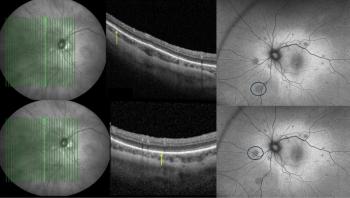
Cross-linking stability remarkable
Corneal crosslinking showed remarkable stability in a recent rabbit study, Dr Gregor Wollensak told delegates during the session on New Surgical Approaches to Keratoconus.
Corneal crosslinking showed remarkable stability in a recent rabbit study, Dr Gregor Wollensak told delegates during the session on New Surgical Approaches to Keratoconus.
"There are good prospects for the long-term stability of the technique, which is of course underlined by the very promising results from the Dresden five-year study, " he said.
Dr Wollensak outlined the biomechanical characteristics of the cornea after collagen crosslinking. "What is crosslinking in every day experience? " he asked. "Age-related crosslinking is where the meat of young animals is soft and tender whereas the meat of older animals is tough. "
Cataract, he said, was an example of crosslinking within the crystalline lens and that chemical crosslinking is demonstrated with formalin-induced hardening in tissue fixation.
He said this was a useful phenomenon in keratoconus because tensile strength of the cornea is reduced about 36% in that condition.
He outlined the standard procedure and told delegates: "So far, so good, but there are two outstanding questions that remain unanswered: What about C3-R? What about long-term stability of the biomechanical effect? "
He explained that C3-R (corneal collagen crosslinking with riboflavin) was introduced in 2004 by Dr. Boxer Wachler to reduce postoperative pain. It uses preoperative anaesthetic eye drops containing benzalkoniumchloride (BAK). This loosens up the tight junctions of the corneal epithelial cells thus allowing transepithelial crosslinking treatment without removal of the epithelium.
Dr Wollensak designed a rabbit experiment to test the efficacy of C3-R against standard corneal crosslinking. Group 1 (corneal crosslinking, n=5) had epithelial debridement, conjuncain and standard riboflavin solution starting 10 min before irradiation.
Group 2 (C3-R; n=5) had no debridement and proparacaine anaesthetic containing BAK starting 30 min before irradiation. Group 3 (C3-R without BAK; n=4) had no debridement, received conjuncaine without BAK 30 min before irradiation.
Results showed that corneal crosslinking had a marked effect on collagen hardening, while C3-R with BAK demonstrated one-fifth of the effect, while C3-R had actually reduced hardness in the cornea.
Dr Wollensak said that human corneas demonstrated a greater crosslinking effect than rabbits, by a factor of 2.5 "A higher degree of natural baseline crosslinking in rabbit cornea means there is more potential for an increase in crosslinking in the human cornea, " he said.
He said in human corneas the result of the rabbit experiment would probably correspond to 65% increase in corneal hardening by C3-R (320% by corneal crosslinking). "On histology, there was only toxicity down to 200 µm. So, C3-R can be recommended for thin corneas due to lower toxicity, but not for routine crosslinking, " Dr Wollensak said.
He also studied the stability of the effect in rabbits, testing the collagen crosslinking effect at one day, three months and eight months.
He said that the long term stability of the biomechanical effect of corneal crosslinking over eight months was remarkable. "Corneal collagen turnover rate is probably very slow like in the tendon or skin, so there are excellent prospects for the stability of corneal crosslinking. "
Newsletter
Get the essential updates shaping the future of pharma manufacturing and compliance—subscribe today to Pharmaceutical Technology and never miss a breakthrough.













































